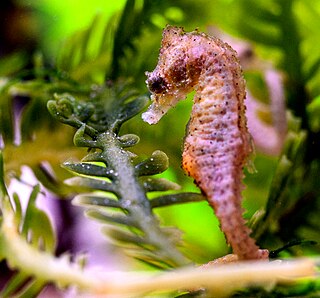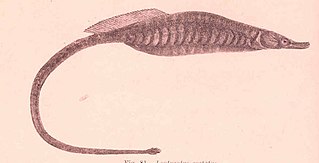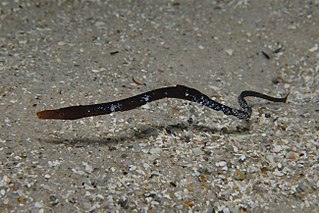
Pipefishes or pipe-fishes (Syngnathinae) are a subfamily of small fishes, which, together with the seahorses and seadragons, form the family Syngnathidae.

The greater pipefish is a pipefish of the family Syngnathidae. It is a seawater fish and the type species of the genus Syngnathus.

The lesser pipefish or Nilsson's pipefish is a pipefish similar to the greater pipefish, but with no crest above the head. Usually it reaches up to 17 centimetres (6.7 in) in length, maximally 18 centimetres (7.1 in), although in South Wales they are usually not more than 10 to 13 centimetres long. They have a light to dark green-brown colour with bar-like markings on the sides.

The dwarf seahorse is a species of seahorse found in the subtidal aquatic beds of the Bahamas and parts of the United States. It is threatened by habitat loss. According to Guinness World Records, it is the slowest-moving fish, with a top speed of about 5 feet (1.5 m) per hour.

The black-striped pipefish is a species of fish in the family Syngnathidae. It is found in the eastern Atlantic from the southern Gulf of Biscay to Gibraltar, also in the Mediterranean and Black Seas. As the introduced species it is mentioned in the Caspian Sea and fresh waters of its basin.

The broadnosed pipefish or deepnosed pipefish is a fish of the family Syngnathidae. It is native to the Eastern Atlantic from Vardø in Norway, Baltic Sea and the British Isles at north to Morocco at south. It is also found in the Mediterranean Sea, Black Sea and Sea of Azov. It is common in the coastal shallow waters, usually on reefs with seagrasses. This species is notable for its "broad" snout, which is as deep as its body.

The northern pipefish is a northwest Atlantic species of fish belonging to the family Syngnathidae.
The chain pipefish is a pipefish species. It inhabits the western Atlantic from Virginia, Bermuda and northern Gulf of Mexico to Campeche and Jamaica, but is absent from the Bahamas. It is a marine subtropical reef-associated fish, up to 38 cm length.
The Yucatán pipefish is a demersal fish species native to the Gulf of Mexico.

The deepbody pipefish is a species of pipefish endemic to Australia where it is only found along the southern coast. This species grows to a length of 12.9 centimetres (5.1 in) SL. This species is the only known member of the monotypic genus Kaupus which is named in honour of the ichthyologist Johann Jakob Kaup (1803-1873).
Americamysis bahia is a shrimp-like crustacean in the order Mysida, the opossum shrimps. It is native to estuarine waters in Texas and Florida in the United States. It is often referred to in the literature as Mysidopsis bahia and is widely cultured and used in the laboratory for toxicology testing.
Choeroichthys latispinosus, also known as the Muiron Island pipefish or Muiron pipefish, is a species of pipefish native to the western coast of Western Australia, named for its recorded sighting on South Murion Island. It is thought to inhabit the area from Port Denison to Brecknock Island in the eastern Kimberley region.

The beady pipefish is a species of pipefish of the family Syngnathidae. It is found in the Indo-West Pacific, from the western Persian Gulf, to the north central Indian Ocean, to Japan and Australia. It lives in the lower parts of streams and rivers, estuarine habitats such as seagrass beds and mangroves, and shallow inshore habitats, where it can grow to lengths of 16–18 centimetres (6.3–7.1 in). It is expected to feed on small crustaceans, similar to other pipefish. This species is ovoviviparous, with males carrying eggs in a brood pouch before giving birth to live young. Average brood size is 177.

Histiogamphelus briggsii, also known as Brigg's pipefish, is a species of marine fish in the family Sygnathidae. It can be found in the shallow waters surrounding South Australia, New South Wales, and Northern Tasmania. Its habitat can consist of reefs, seagrass beds, and sandy beach and estuarine environments Individuals of this species can grow to lengths of 25 cm (9.8 in). They are an ovoviviparous species, in which males brood eggs and give birth to live young.
Stigmatopora narinosa, also known as the Southern Gulf pipefish is a species of marine fish belonging to the family Syngnathidae. The species can be found in patches of seagrass and algae in the shallow waters of Spencer Gulf and the Gulf St. Vincent, South Australia. Their diet likely consists of small crustaceans such as copepods and amphipods. Adult males have been measured at lengths up to 11.3 centimeters. Reproduction occurs through ovoviviparity in which the males brood eggs from December to March before giving live birth.
Stigmatopora nigra, also known as the wide-bodied pipefish is a species of marine fish belonging to the family Syngnathidae. This species can be found in the shallow waters, bays, and estuaries of southern Australia from Shark Bay to Brisbane, Tasmania, and New Zealand. They often inhabit seagrass or algae beds in addition to bare sand. Their diet consists of small crustaceans such as copepods and amphipods. Adult brooding males have been measured at 6.5-7 centimeters. Reproduction occurs through ovoviviparity. in which the males brood up to 25 eggs in a pouch below the tail before giving live birth. Stigmatopora nigra can live to 150 days old and are able to reproduce throughout the year.

Urocampus nanus, commonly known as the barbed pipefish, is a species of marine fish belonging to the family Syngnathidae. This family consists of 56 different genera and 320 species.
Trachyrhamphus longirostris, also known as the long-head pipefish or straightstick pipefish, is a species of marine fish belonging to the family Syngnathidae. They can be found in muddy estuaries on the continental shelf throughout the Indo-Pacific from Eastern Africa to the Solomon Islands and Japan. The diet of Trachyrhamphus longirostris likely consists of small crustaceans. Adult individuals can grow to be approximately 33 centimeters in length. Reproduction occurs through ovoviviparity in which males brood eggs before giving live birth.

Vanacampus vercoi, also known as Verco's pipefish is a species of marine fish belonging to the family Syngnathidae. They can be found inhabiting seaweed and seagrass beds in addition to tidepools at depths between 2–4 meters from Spencer's Gulf to Encounter Bay, South Australia. Their diet likely consists of small crustaceans such as amphipods and copepods. Reproduction occurs through ovoviviparity in which the males brood eggs before giving live birth.

Vanacampus phillipi, also known as the Port Phillip pipefish is a species of marine fish belonging to the family Syngnathidae. They can be found inhabiting seaweed and seagrass beds along the southern coast of Australia from Perth to Jervis Bay, New South Wales including the coast of Tasmania. Their diet consists of small crustaceans such as copepods, amphipods, and mysid shrimps. Reproduction occurs through ovoviviparity in which the males brood eggs before giving live birth to 50 or less offspring.















